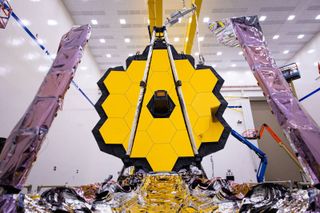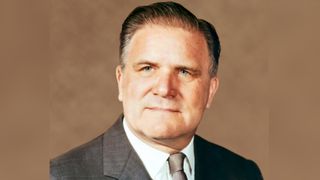It's official: NASA won't rename James Webb Space Telescope
The agency has cleared former NASA chief James Webb of persecuting LGBTQ+ staffers.

The most powerful space telescope currently in operation will retain its controversial name.
The James Webb Space Telescope launched in December 2021 amid calls for the observatory to be renamed. The observatory was named in 2002 after government bureaucrat James Webb, who served as the second administrator of NASA during the 1960s. But opponents of the name argue that Webb persecuted people known or suspected to belong to the LGBTQ+ community. Now, NASA has concluded an investigation into Webb's role in what's been dubbed the Lavender Scare, and the agency has decided to leave his name on the $10 billion telescope.
"To date, no available evidence directly links Webb to any actions or follow-up related to the firing of individuals for their sexual orientation," the report reads. "Based on the available evidence, the agency does not plan to change the name of the James Webb Space Telescope," NASA officials wrote in a statement announcing the report.
Gallery: James Webb Space Telescope's 1st photos
As early as spring 2021, astronomers were raising concerns about Webb's record; by September, a petition calling for a new name for the observatory was gathering signatures. At the end of September, current NASA Administrator Bill Nelson said the agency would not change the name. In March of this year, with the telescope safely in orbit, documents about the investigation obtained through freedom of information policies and released by the journal Nature reinvigorated the debate. In April, NASA officials said that their investigations into Webb's record were continuing; since then, attention has focused on the science the observatory is already conducting.
In a statement released Friday (Nov. 18), NASA officials exonerate Webb while condemning broader federal government actions in the 1950s during what is called the "Lavender Scare" in a nod to the intertwined but better remembered "Red Scare" persecution of suspected communist supporters that began in 1950. The Lavender Scare included a surge in discrimination against and persecution of government employees who were suspected of being what one 1950 document cited in the report called "homosexuals and other moral perverts."
"For decades, discrimination against LGBTQI+ federal employees was not merely tolerated, it was shamefully promoted by federal policies," Nelson said in the new statement. "The Lavender Scare that took place following World War II is a painful part of America's story and the struggle for LGBTQI+ rights."
Get the Space.com Newsletter
Breaking space news, the latest updates on rocket launches, skywatching events and more!
The full report, available online, runs 87 pages, about half of which is filled by images of historical documents dubbed "key evidence." In addition, an executive summary states that, as part of the investigation, NASA Chief Historian Brian Odom consulted "thousands of documents" while an unidentified outside historian contracted to the project "survey[ed] over 50,000 pages covering the period from 1949-1969."

Webb served as NASA's second administrator from 1961 to 1968, leading the agency as it feverishly worked to execute the Apollo program and land astronauts on the moon in 1969. But the role wasn't his first in government; he spent a few years with the Treasury, then joined the Department of State as an undersecretary of state in 1949, a role he held until 1952 — hence the two-decade range of the examined documents.
Opponents of the observatory's name have argued that Webb was complicit in the Lavender Scare during both appointments. The investigation seems to have interrogated Webb's record more narrowly. "The central purpose of this investigation was to locate any evidence that could indicate whether James Webb acted as a leader of or proponent for firing LGBTQ+ employees from the federal workforce," the executive summary begins.
Peering into the past
As detailed in the report, the investigation into Webb's activities focused on a pair of meetings Webb attended in 1950 and the 1963 firing of a NASA budget analyst named Clifford Norton.
The report's authors studied events and documents dating back to early 1950, as the government began pursuing perceived security risks in its ranks; leaders at the time regarded sexual orientation as a risk factor, in part because of concerns about blackmail. In June, Webb attended two key meetings: one with President Harry Truman and one with U.S. Sen. Clyde Roark Hoey (D-North Carolina).
Before discussing those incidents, the report offers a detailed history of the six months prior, focusing particularly on the activities of John Peurifoy, then the deputy undersecretary of state for administration, which was the third-ranking job in the department according to his New York Times obituary.
Peurifoy was one of two officials leading the department's internal security program, according to the report. He also served as the department's representative to the notorious committee led by Hoey dedicated to investigating the "problem" of "the employment of homosexuals and other sex perverts in government."
The report paints Peurifoy as a leader in the anti-LGBTQ+ activities of the department's leadership until his departure in August 1950 and notes that the State Department had concluded the Hoey Committee would have limited access to its secretary and undersecretary .
"Because of this, it is a sound conjecture that Webb played little role in the matter, from either an administrative or philosophical perspective, beyond the June 28, 1950, meeting with Senator Hoey," the report states, adding that the investigation didn't find any documents that tied Webb to the committee.
"Based upon the available evidence, Webb's main involvement was in attempting to limit Congressional access to the personnel records of the Department of State," the report states of the June 28 meeting. "During that meeting, Webb did pass along to Senator Hoey 'some material on the subject [of homosexuality] which [Carlisle] Humelsine of State had prepared.' None of the evidence found links Webb to actions emerging from this discussion."
The other meeting analyzed during the investigation occurred about a week prior; the report argues that meeting allowed Truman and Webb to strategize about how to respond to the committee without ceding power from the White House to Congress.
Time at NASA
The final incident analyzed in the new report is the 1963 firing of NASA budget analyst Clifford Norton. The report lays out that the D.C. "Moral Squad" spotted Norton and another man, who separately drove to Norton's parking lot. The other man told the police that Norton had "'felt his leg' and extended an invitation to his apartment."
Both men were arrested and brought in for questioning; Norton denied making advances on the other man. But the head of the Moral Squad called the NASA Security Chief, who questioned Norton again separately and fired him. Norton later sued for wrongful termination; the court found in his favor in 1969, after Webb had left the agency.
"The action against Norton was, as mentioned by his boss Robert F. Garbarini, 'custom within the agency' at the time he was fired," the report states. "Numerous research efforts of NASA History archival collections, those at the National Archives, and related repositories have turned over no direct evidence that Webb ever knew anything about Norton's firing from the agency, as the action taken against Norton was consistent with civil service policy."
The report ends with a description of the archives Odom and others consulted during the process, as well as images of some of the documents included.
Both the 1950 meetings and the Norton case have been presented by those opposed to honoring Webb as incidents of complicity. The memos he passed to Hoey fed the Lavender Scare, some say, and Puerifoy wouldn't have acted as he did had his superiors, Webb included, objected; similarly, the 1963 incident would have played out differently if Webb opposed Norton's firing, some argue.
Some also posit that, when it comes to an honor as prestigious as having a world-class observatory named for a historical figure, that person should meet a higher standard than there simply not being any evidence to condemn him.
Others disagree about how much responsibility Webb bears. University of South Florida historian David Johnson, who wrote a book about the Lavender Scare, says that condemning Webb ignores the context of the time and the force of the government's anti-LGBTQ+ campaign, estimating that 5,000 to 10,000 federal employees were fired over the course of the Lavender Scare.
"It was routine, it was a standard government policy. There was no way that Webb could have intervened and said, 'No, we're not going to fire this gay person,'" he told Space.com during an interview in the spring. The same premise holds for Webb's time at the State Department: "They weren't standing up and saying gay people should have equal rights, because nobody was saying that in 1950, including gay people," he said.
"If we're going to fault James Webb for the Lavender Scare, we would have to change the names of a lot of things and a lot of buildings," he said, highlighting NASA's Johnson and Kennedy space centers. "None of these people were particularly active in persecuting homosexuals, but just like Webb, they were there when this policy was in effect."
Odom pointed to the same conundrum in an email written in March 2021 and released this spring. "Recommendation: Don't change the name at this point. Stop naming things after people [he says half joking]," he wrote.
Email Meghan Bartels at mbartels@space.com or follow her on Twitter @meghanbartels. Follow us on Twitter @Spacedotcom and on Facebook.
Join our Space Forums to keep talking space on the latest missions, night sky and more! And if you have a news tip, correction or comment, let us know at: community@space.com.

Meghan is a senior writer at Space.com and has more than five years' experience as a science journalist based in New York City. She joined Space.com in July 2018, with previous writing published in outlets including Newsweek and Audubon. Meghan earned an MA in science journalism from New York University and a BA in classics from Georgetown University, and in her free time she enjoys reading and visiting museums. Follow her on Twitter at @meghanbartels.
